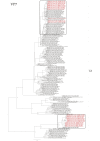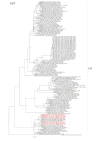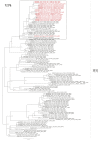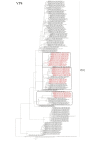Phylogenetic Analyses of Rotavirus A from Cattle in Uruguay Reveal the Circulation of Common and Uncommon Genotypes and Suggest Interspecies Transmission
- PMID: 32674420
- PMCID: PMC7400708
- DOI: 10.3390/pathogens9070570
Phylogenetic Analyses of Rotavirus A from Cattle in Uruguay Reveal the Circulation of Common and Uncommon Genotypes and Suggest Interspecies Transmission
Abstract
Uruguay is one of the main exporters of beef and dairy products, and cattle production is one of the main economic sectors in this country. Rotavirus A (RVA) is the main pathogen associated with neonatal calf diarrhea (NCD), a syndrome that leads to significant economic losses to the livestock industry. The aims of this study are to determine the frequency of RVA infections, and to analyze the genetic diversity of RVA strains in calves in Uruguay. A total of 833 samples from dairy and beef calves were analyzed through RT-qPCR and sequencing. RVA was detected in 57.0% of the samples. The frequency of detection was significantly higher in dairy (59.5%) than beef (28.4%) calves (p < 0.001), while it did not differ significantly among calves born in herds that were vaccinated (64.0%) or not vaccinated (66.7%) against NCD. The frequency of RVA detection and the viral load were significantly higher in samples from diarrheic (72.1%, 7.99 log10 genome copies/mL of feces) than non-diarrheic (59.9%, 7.35 log10 genome copies/mL of feces) calves (p < 0.005 and p = 0.007, respectively). The observed G-types (VP7) were G6 (77.6%), G10 (20.7%), and G24 (1.7%), while the P-types were P[5] (28.4%), P[11] (70.7%), and P[33] (0.9%). The G-type and P-type combinations were G6P[11] (40.4%), G6P[5] (38.6%), G10P[11] (19.3%), and the uncommon genotype G24P[33] (1.8%). VP6 and NSP1-5 genotyping were performed to better characterize some strains. The phylogenetic analyses suggested interspecies transmission, including transmission between animals and humans.
Keywords: bovine; diarrhea; genotypes; interspecies transmission; rotavirus.
Conflict of interest statement
The authors declare no conflict of interest. The funders had no role in the design of the study; in the collection, analyses, or interpretation of data; in the writing of the manuscript, or in the decision to publish the results.
Figures






Similar articles
-
Molecular surveillance of rotavirus A associated with diarrheic calves from the Republic of Korea and full genomic characterization of bovine-porcine reassortant G5P[7] strain.Infect Genet Evol. 2022 Jun;100:105266. doi: 10.1016/j.meegid.2022.105266. Epub 2022 Mar 9. Infect Genet Evol. 2022. PMID: 35276340
-
Phylogenetic analyses of typical bovine rotavirus genotypes G6, G10, P[5] and P[11] circulating in Argentinean beef and dairy herds.Infect Genet Evol. 2013 Aug;18:18-30. doi: 10.1016/j.meegid.2013.04.023. Epub 2013 Apr 26. Infect Genet Evol. 2013. PMID: 23624201
-
Cross-sectional study of the G and P genotypes of rotavirus A field strains circulating in regularly vaccinated dairy cattle herds.Trop Anim Health Prod. 2019 May;51(4):887-892. doi: 10.1007/s11250-018-1769-2. Epub 2018 Dec 8. Trop Anim Health Prod. 2019. PMID: 30535644
-
Molecular Epidemiology of Rotavirus A in Calves: Evolutionary Analysis of a Bovine G8P[11] Strain and Spatio-Temporal Dynamics of G6 Lineages in the Americas.Viruses. 2023 Oct 19;15(10):2115. doi: 10.3390/v15102115. Viruses. 2023. PMID: 37896894 Free PMC article.
-
Porcine group A rotaviruses with heterogeneous VP7 and VP4 genotype combinations can be found together with enteric bacteria on Belgian swine farms.Vet Microbiol. 2014 Aug 6;172(1-2):23-34. doi: 10.1016/j.vetmic.2014.04.002. Epub 2014 Apr 13. Vet Microbiol. 2014. PMID: 24837191 Review.
Cited by
-
Detection and Genetic Characterization of Bovine Torovirus in Uruguay.Viruses. 2024 May 24;16(6):835. doi: 10.3390/v16060835. Viruses. 2024. PMID: 38932127 Free PMC article.
-
Rotaviruses A and C in dairy cattle in the state of Rio de Janeiro, Brazil.Braz J Microbiol. 2022 Sep;53(3):1657-1663. doi: 10.1007/s42770-022-00764-8. Epub 2022 Apr 27. Braz J Microbiol. 2022. PMID: 35478312 Free PMC article.
-
Metagenomic insights into the complex viral composition of the enteric RNA virome in healthy and diarrheic calves from Ethiopia.Virol J. 2025 Jun 7;22(1):188. doi: 10.1186/s12985-025-02821-8. Virol J. 2025. PMID: 40483486 Free PMC article.
-
Determination of an RT-qPCR viral load cutoff point for the etiologic diagnosis of rotavirus A diarrhea in neonate dairy calves.Front Vet Sci. 2022 Aug 12;9:952197. doi: 10.3389/fvets.2022.952197. eCollection 2022. Front Vet Sci. 2022. PMID: 36032290 Free PMC article.
-
Detection and molecular characterization of major enteric pathogens in calves in central Ethiopia.BMC Vet Res. 2024 Sep 4;20(1):389. doi: 10.1186/s12917-024-04258-7. BMC Vet Res. 2024. PMID: 39227796 Free PMC article.
References
-
- Urie N.J., Lombard J.E., Shivley C.B., Kopral C.A., Adams A.E., Earleywine T.J., Olson J.D., Garry F.B. Preweaned heifer management on US dairy operations: Part V. Factors associated with morbidity and mortality in preweaned dairy heifer calves. J. Dairy Sci. 2018;101:9229–9244. doi: 10.3168/jds.2017-14019. - DOI - PMC - PubMed
Grants and funding
LinkOut - more resources
Full Text Sources
Research Materials
Miscellaneous

